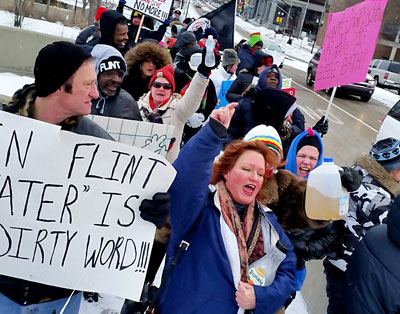
Vol. 80/No. 5 February 8, 2016
(front page)
Poisoning of water in Flint reflects
capitalists’ disdain for working class

“The water coming out of our faucets was discolored, it either smelled like a swimming pool with so much chlorine or like sewage,” she said. Residents of this working-class city started bringing bottles of the water to City Council meetings. “It looked like English tea,” McClinton said, “and all the while they’re telling us it’s safe to drink.”
The story of how the water was poisoned is an indictment of capitalism and ruling-class scorn toward the residents of this working-class city. Every level of government — from the city to the governor to the U.S. Environmental Protection Agency — was complicit. It made no difference whether the officials were Democrats or Republicans, Black or Caucasian.
But it’s also the story of working people who refused to accept the lies. “We were being dismissed and ridiculed and called names,” LeeAnne Walters said by phone Jan. 24. “We had no choice but to fight.” Walters, a housewife and former medical assistant, was one of the first to learn there were high levels of lead in her home’s water. One of her children was diagnosed with lead poisoning.
Flint residents jammed City Council meetings, organized their own community forums and held street protests.
“That’s the best part of what happened,” Walters said. “It brought the community together, we put aside our differences and we joined forces.” Flint has the highest official poverty rate of any city in Michigan. Its population is 55 percent African-American and 35 percent Caucasian.
The crisis stems from the decision by Flint Emergency Manager Darnell Earley — appointed by Republican Michigan Gov. Richard Snyder in 2013 to take over all financial powers of the local government — to switch to Flint River water.
“He had the idea it would be cheaper than the pretreated water we had been getting from Detroit for 40 plus years,” Rev. Alfred Harris, president of Concerned Pastors for Social Action, told the Militant.
In October 2014, less than six months after the switch, General Motors said it would no longer use Flint water at its engine plant because it was causing corrosion. “You don’t need to be a rocket scientist to know if it’s not safe for engine parts, then it sure as hell isn’t safe for human beings,” McClinton said.
In January 2015 the Michigan Department of Environmental Quality found high levels of a carcinogenic byproduct of chlorine used to disinfect the water. That same month the first tests showing dangerous levels of lead in the water became public.
Yet three months later Mayor Walling was still tweeting, “[My] family and I drink and use the Flint water everyday, at home, work, and schools.”
Researchers from Virginia Tech University — spurred by a call from Walters — tested water from 300 Flint homes. They announced the results in September: high lead levels in more than 25 percent of homes, as much as 13,200 parts per billion. According to the Centers for Disease Control and Prevention anything above 15 parts per billion is a danger, especially to children and pregnant women.
That same month, Dr. Mona Hanna-Attisha, a pediatrician with Hurley Children’s Hospital, said tests had found that 4 percent of Flint children had dangerous levels of blood lead, double the numbers before the water switch and in some places triple.
Some government officials still denied there was any danger. Michigan Department of Environmental Quality spokesperson Brad Wurfel told the Flint Journal that those publicizing the problem were fostering “near-hysteria.”
Federal EPA officials said the lead was within safe levels. An internal EPA memo in June 2015 warned that high lead was a “serious concern” but the agency did nothing to alert the public.
But the truth began to win out. Flint River water is 19 times more corrosive than Detroit’s Lake Huron treated water, yet Flint authorities did not add a simple corrosion inhibitor to the water. This would have prevented lead from leaching from decades-old pipes, for only $100 a day. The damage now is probably irreversible. The cost of replacing pipes could reach $1.5 billion.
On Oct. 1, officials of Genesee County, where Flint is located, declared a public health emergency and urged residents to stop drinking the water, something many, if not most, had already done.
In January this year, President Barack Obama declared a federal emergency in Flint but refused to make a “disaster” declaration, which would have meant more funds for the city. He has authorized $5 million for buying bottled water and lead filters and additional loans.
The aid offered so far “it’s not even a drop in the bucket,” said Rev. Harris. “It’s a Band-Aid that’s all it is.”
Flint residents are still forced to use bottled water and install lead filters. The city has jacked up water rates, some people are paying $150 a month or more “for water they can’t even use,” Harris notes.
“We have won some victories,” said McClinton. “The latest is getting national attention. We were able to get them to go back to using Detroit water. But we need structural repairs. We need the Army Corp of Engineers. We need a special health facility to monitor, especially for our children because lead damage is irreversible.”
“This fight is far from over,” said Walters.
Front page (for this issue) | Home | Text-version home